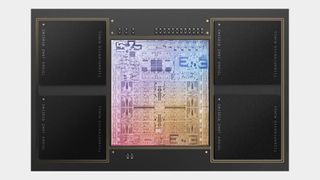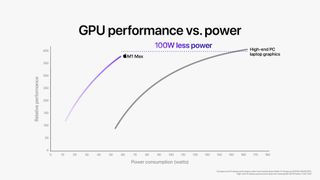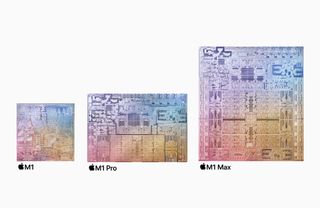Apple claims its new M1 Max chip is a match for Nvidia's RTX 3080, but should we believe it?
Apple has two new chips ready to go, the M1 Max and M1 Pro, and they've come out of the gate swinging at Intel and Nvidia.

Apple has unleashed two new processors for Macs: the M1 Pro and the M1 Max. These homegrown Arm-based chips are revamped, and much larger, versions of the M1 launched last year, and include memory, CPU, and GPU all under one roof.
Apple even says its new GPU is a match for Nvidia's RTX 3080 mobile chip, though you'll have to take Apple's word for it on that one. We've also reached out to Nvidia to see what it might have to say on the matter.
The M1 Max is the larger of the two chips, or rather system-on-chips (SoCs), at a whopping 57 billion transistors, and that means it comes with the most memory, most cores, and claims the largest performance wins. It's a 10-core CPU with eight performance cores and two efficiency cores, a 32-core GPU, and up to 64GB of memory.
Each of those GPU cores comes with 16 Execution Units, each of those containing 8 ALUs. That makes for a 4,096 ALU GPU within the M1 Max.
And Apple says that's enough to deliver "performance similar to that of the highest-end GPU in the largest PC laptops while using up to 100 watts less power."
Check out its graph to prove it. Just bear in mind Apple is not offering any indication of the benchmarks it used to gather these figures, only that it collected them "using select industry-standard benchmarks". So, exciting to look at, but not really all that useful.

The laptop Apple is rating performance against is the MSI GE76 Raider (11UH-053), which comes with an Nvidia GeForce RTX 3080 mobile GPU with 16GB GDDR6, an Intel Core i9 11980HK, and 32GB of RAM.
The biggest gaming news, reviews and hardware deals
Keep up to date with the most important stories and the best deals, as picked by the PC Gamer team.
So let's try and understand what's actually going on with Apple's new GPU, to better determine what we can actually expect from the M1 Max.
Apple says the GPU within the M1 Max is four times faster than the GPU in the M1, which checks out because it's exactly four times larger. The full eight-core M1 is rated to roughly 2.6 TFLOPS, so we're looking at a GPU in the M1 Max that's in the area of 10.4 TFLOPS.
That's actually quite a long way off the 18.98 TFLOPS of the RTX 3080 Mobile running at top speed, as it should in the MSI GE76 Raider. Apple's chip falls closer to the RTX 3060, in fact.
So how is Apple saying its M1 Max is that much faster?


Best chair for gaming: the top gaming chairs around
Best gaming desk: the ultimate PC podiums
Best PC controller: sit back, relax, and get your game on
Well, that's probably going to come down to the benchmarks which Apple has decided to run for testing purposes. The way in which the M1 Max chip is constructed, the large unified memory pool available to the GPU and CPU, and even the programming language used down to the metal will make a huge difference to how Apple and Nvidia's chips perform under different circumstances.
The M1 Max comes with 400GB/s of memory bandwidth and access to lots of it. That means any workload that utilises all the available memory bandwidth could perform really well on the M1 Max.
And we've no real indication of what was used to test, which is the real kicker here. I'd take a swing at saying it was a benchmark more representative to the professional creative applications Apple expects its M1 Max to be used for, and almost certainly nothing related to gaming.
That's not Apple's cup of tea. Though it is interesting in itself that Apple would use a gaming laptop for comparison here.
In answering my own question posed in the headline: should you believe Apple's GPU performance stats? There's sure to be truth behind the figures, but the devil is in the details, which we don't have yet.


The bigger story out of Apple's Mac announcement event perhaps is the touted power demands of the M1 Max and M1 Pro, which are far lower than their competition. Again, context is everything, but from an already power-savvy design with the M1 to the use of TSMC's latest 5nm process node, it makes sense as to how Apple could be saving so much while still stuffing so many transistors in.
No doubt these two chips are an impressive feat of engineering, and they're also pretty stunning ones, too. Just don't get hung up on the price too much, the M1 Max will set you back at least $3,499. As for their impact on PC gaming, well, you probably won't hear much more about them, but you could look to Apple's current success with its own Arm-powered chips as a benefit to PC gaming, in a way: If kicking Intel out of Macs has put more pressure on Intel to deliver bigger and better chips, which it most certainly has, that's only to the benefit of us lot buying PCs and laptops with Intel inside.

Jacob earned his first byline writing for his own tech blog. From there, he graduated to professionally breaking things as hardware writer at PCGamesN, and would go on to run the team as hardware editor. He joined PC Gamer's top staff as senior hardware editor before becoming managing editor of the hardware team, and you'll now find him reporting on the latest developments in the technology and gaming industries and testing the newest PC components.
Most Popular





